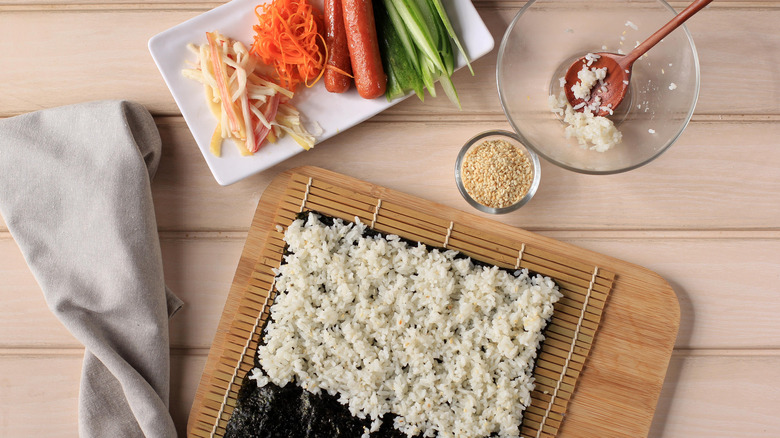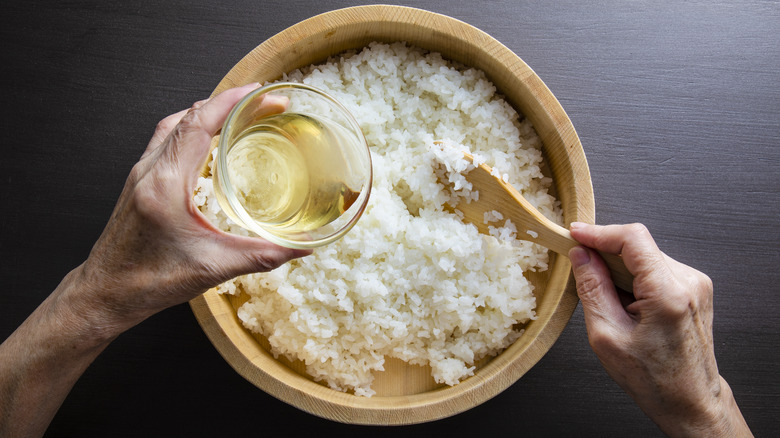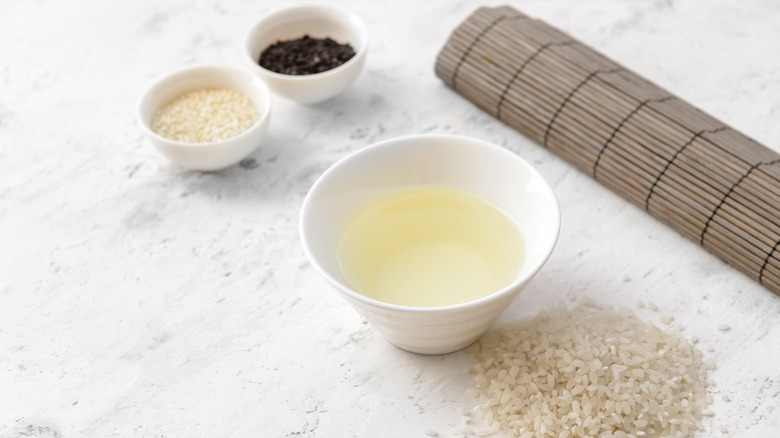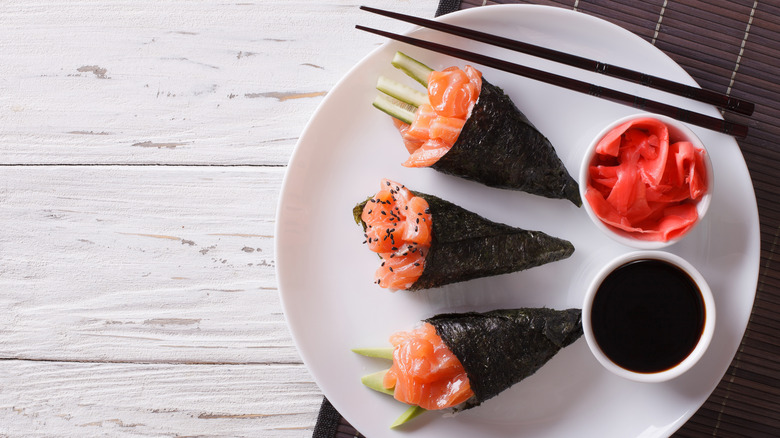12 Tips For Making Homemade Sushi
There's no better satisfaction than recreating one of your favorite dishes at home, especially when that meal is something as delicious as your favorite sushi roll. With its notoriety of being a carefully hand-crafted delicacy behind sushi counters by the hands of professionals, many may think that sushi is a lot harder to recreate at home than it actually is. With a little bit of effort and a lot of attention to detail, you can easily recreate an at-home experience that rivals your favorite sushi restaurant.
While sushi looks to be a clean, simple food, there are a lot of small moving parts that can make or break a good roll. From gathering the ingredients to the construction of the roll itself, there are a few tips and tricks that we've stumbled upon with experience in homemade sushi making that are certain to make your experience a success. From a mix of personal methodologies paired with some advice from reputable sources on the topic, including celebrity chefs' expert tips, we're bringing you all of the insider knowledge you need to create a whole sushi menu of your own; what could be better than a selection of your own, custom-made sushi rolls?
Figure out what kind of sushi you like
This may seem like a giveaway, but it's important to know which sushi rolls you actually like before attempting to recreate them at home. While some of the ingredients will be standard across every roll, there's a wide array of fillings and toppings that typically make up the rolls that you might find on a sushi restaurant's menu. Think about the rolls you order regularly at your go-to sushi spot, and consider using these as inspiration before buying all of the ingredients needed for homemade sushi.
Pre-planning the rolls you want to make will also help given that some rolls are more complex, involving more steps and ingredients than others. If this is your first time making homemade sushi, a roll with simpler ingredients and fewer moving parts may make the process smoother. Using tried and true sushi roll flavor combinations is also best to start with rather than throwing together random ingredients. Take for example a classic California roll, a Philadelphia roll, or a tuna and cucumber roll — all simple, only three ingredients, and absolutely delicious. Try sticking to what works if you are just starting out, and consider getting more adventurous once you've mastered some of the basics.
Try shopping at a local Asian grocery store
Once you know what to shop for, we recommend locating an Asian grocery store nearest to you to find all of the ingredients you need. While a regular grocery store might suffice, Asian grocery stores will often have some of the more niche ingredients needed when making Asian recipes like sushi. These specialty markets also have a wide selection to choose from for each ingredient, including the best quality of that given item that a regular grocery store might strictly have a generic version of.
Some common examples include H Mart or 99 Ranch Market, two popular favorites with multiple locations across various states. You can almost always depend on these supermarkets to have the things you'll need, from fresh fish to finer details like toppings, sauces and seasonings. If you are using raw fish, it's more likely that you will be able to find the best selection of raw fish at an Asian supermarket rather than your run-of-the-mill grocery store.
Other small ingredients that make a big difference in your at-home dining experience are things like masago, wasabi powder, and ginger, which can all be easily found at an Asian grocery store. If you're lucky enough to live near one of these, there's no question that it should be a go-to for the freshest sushi ingredients.
Buy the best quality fish possible
Now that we've established where to buy the freshest ingredients from, it is also important to know how to choose the best quality fish for your homemade sushi. Preparing raw fish can be a daunting task, so it is best to be sure that you're dealing with carefully curated seafood selections. There's a large difference between any piece of raw fish you might find at the grocery store and what's designated as safe for consumption raw.
You may have heard the terms "sushi-grade" or "sashimi-grade" when referring to the most common types of raw fish that are thought of as safest for consumption. While there aren't any special processes that these products go through to make them better for consumption, it's true that selecting raw fish with either label is generally the safest route when dealing with preparing it at home.
As mentioned above, finding a specialty market is another helpful way to ensure that your fish is the best quality possible. The employees working behind the seafood counters at these establishments will be able to distinguish which fish can be eaten raw from those that can't, so asking them will be a surefire way to ensure that the fish you choose is safe for consumption.
Utilize pre-cooked protein options
If raw fish is not for you, there are plenty of other protein options for sushi, whether it's a pre-cooked fish or a vegetarian option. The beauty of homemade sushi is that it can be customized to fit any liking.
One great option is canned tuna or salmon, which can be used plain or mixed with mayo and sriracha to mimic a spicy tuna or salmon roll without using raw fish. Another alternative to raw fish is crab stick, or surimi, which is the imitation crab that is often used in restaurants. Peel this ready-made fish into thin slices and chop it up to make a crab salad sushi, or put it into your roll whole with other vegetables, and you have a delicious roll without the fuss of raw fish.
To omit fish altogether, consider using other proteins like tofu or egg. Using a starchy vegetable like sweet potato is a delicious way to pack more flavor into vegetarian or vegan sushi. Another less commonly known option that can make a great addition to sushi is Spam. This canned, salty meat is a quick, easy addition that will certainly add a burst of flavor to a sushi roll. Otherwise, other vegetables like avocado, cucumber, or even eggplant are often used to fill or top rolls if you are looking to leave meat or protein out of the picture entirely.
Do some research
Before diving into your homemade sushi, do some research to familiarize yourself with the process so you know what you're getting yourself into. Set your future self up for success, and do a little bit of extra preparation to make sure the process is as smooth as possible. The good news is, if you are already here, you've taken a step in the right direction.
Without doing research, you may underestimate how much detail goes into preparing this dish at home. There's nothing worse than going to make something only to find out that you aren't properly equipped. So, take the time to figure out all of the materials you will need for the best home-cooking experience possible.
Sushi can incorporate a wide range of items depending on which type of flavors you are recreating, as well as some essential ingredients for constructing a solid roll. Aside from the ingredients, a lot of the know-how when it comes to crafting a roll is just a Google search away, but it will go a long way in terms of making the process more approachable.
Prepare the rice correctly
Out of all the steps in homemade sushi, the rice is the first place where you can make a costly mistake. It may not seem like there is not a lot of room for error when it comes to rice, but every detail counts when you are trying to craft the perfect at-home sushi roll — especially if it is your first time.
Before preparing anything, you want to ensure that the grain of rice you're using is correct. Generally, any short-grain rice is the best option for sushi due to its high starch and moisture content. These factors come into play when cooking the rice at high temperatures, as the starches break down and help to give the rice the sticky texture characteristic of sushi rice.
The next critical step in preparing the rice comes with seasoning it properly to ensure that it takes on a sticky consistency. This is done by heating vinegar, sugar, and salt and pouring this mixture over your cooked (and cooled) rice. Make sure to give the rice plenty of time to cool after incorporating the seasoning, as this is when the stickiness will set in and make the rolling process easier. Once your rice is set, you're ready for the most exciting part: the roll itself.
Get the right tools
Aside from your hands, there are a couple of tools that are necessary for successful homemade sushi from start to finish. The first and most obvious tool that you'll need is a bamboo sushi mat. If you've seen any at-home sushi-making tutorials, then you are familiar with this handy tool that helps to tightly wrap your roll and prevent the contents from sticking to your hands.
This may go without saying, but a rice cooker will go a long way in making this whole process easier. While the stovetop will get the job done, a rice cooker is low maintenance and guarantees that your rice will be cooked perfectly. On that note, a rice paddle is another handy tool for when it comes time to flatten your rice in a smooth pattern atop the sheet of nori.
Lastly, using a sharpened chef's knife is the best tool for the last step in the process — the actual slicing of the sushi roll. A higher quality, sharpened knife will help to avoid the roll sticking or coming apart while cutting it and make for a perfectly cut roll.
Prepare everything beforehand
We are all about efficiency here, and part of that means creating less work for an all-around amazing at-home sushi experience. If it isn't already apparent, there are a lot of small pieces to this puzzle. To simplify, it is best to have all of the ingredients prepped beforehand rather than trying to do everything at once.
The best approach is to take the extra time beforehand to chop all your vegetables and lay them out so they can be added to the roll when you are ready. Make sure your fish is prepared how you want it, whether it's plain or mixed with other ingredients. Lastly, and perhaps most importantly, make sure that your rice has had time to cook and fully cool down before you are ready to make your rolls. Consider making your rice the day before, even, to ensure plenty of time.
Line up all of your ingredients as if creating your very own assembly line, and you've created your very own sushi kitchen at home. This way, all that is left to do is fill the roll and make sure that it is rolled and sealed properly.
Keep your hands wet
One of the biggest pitfalls when it comes to making homemade sushi is using dry hands when constructing the actual roll. To prevent the rice from sticking to your hands, a general tip is to keep your hands a little wet throughout the process. Some may advise you to keep a bowl of water beside you, but you can also take the extra mile by using some of the rice vinegar to keep your hands wet. Either way, make sure there is a barrier between the clingy rice and your hands.
This tip is important, especially if you are hand-pressing the rice onto the sheet of nori, to avoid the rice sticking to your hands while you are trying to create a flat, even surface. You don't need to soak your hands in water completely — we don't want to make a soggy roll. Rather, keep a few drops of liquid on your fingertips to make sure they're damp at all times. Another way to help the rolling process is by wearing cooking gloves to provide another layer between your hands and the sticky rice.
Try making simple hand rolls to start
If you love sushi, then you are also familiar with its delicious, handheld counterpart, the hand roll. Hand rolls are essentially sushi rolls that haven't been sliced, and these handheld bites are a delicious way to enjoy your sushi in a different way. They're also a great option for homemade sushi, especially for first-timers, to simplify the process and cut down some of the steps.
You can think of a hand roll as a sushi taco, more or less. All that this requires is a standard sheet of nori seaweed, which you will cut in half before filling. Start by adding a small amount of rice to the center of the sheet, and follow with a small portion of your fillings of choice. All that's left is to roll the nori, creating an ice cream cone-like shape.
A helpful tip for hand rolls is to consume them immediately to avoid the nori getting soggy quickly. These rolls, as with sushi in general, are not meant to be kept for an extended period of time and are intended to be enjoyed while they are as fresh as possible.
Be creative with the fillings
The best part about making homemade sushi is that you control exactly what goes into the roll. It may take a couple of tries to master the basics of at-home sushi, but once you've become familiar with the sushi-making process, it's the perfect time to play with different textures and flavors by getting creative with fillings and toppings.
One way to add a bit of crunch to your rolls is with crunchy garlic and onion pieces, or if you're feeling adventurous, try a tempura at home. A perfect tempura can coat any of your fillings, vegetables, and proteins alike, packing your sushi with fried deliciousness. Another topping, and an underrated way to add some flavor to a roll, is with seasoning. Don't underestimate the power of some sesame seeds, which can bring a subtle nutty taste to finish off your roll.
A great addition to sushi that is less commonly seen is fruit. A slice of mango or pineapple can bring a bite of sweetness and freshness to any roll. A little bit goes a long way with these fruits, so a thin slice of either will suffice as the perfect complement to neutral vegetables or even spicier, saltier fish.
Don't forget the sauces
While the sushi roll itself is definitely the star of the show, it also serves as a vessel for delicious sauces. We're not talking about a basic soy sauce on the side, although a side of soy sauce with wasabi and ginger is a must-have when recreating the sushi restaurant experience at home. Rather, we are talking about the array of sauces that can be used to elevate any sushi and can easily be added to a homemade roll.
If you're looking to give your roll a bit of a kick, spicy mayo is an obvious go-to for any roll. This combination of sriracha and mayonnaise is a staple in most sushi restaurants and is super easy to make yourself or find in stores. Another spicy option with a twist of other flavors is a sweet, tangy chili sauce. For a richer sauce to dip your sushi in, yum-yum sauce is a classic Japanese dipping sauce often seen at Japanese steakhouses. This mayo-based, creamy sauce is a great addition to your rotation.
The point is that there's no limit to the number of sauces that can be used to elevate sushi, with the extra benefit of being able to control how much or how little you want to add to your homemade sushi. Many of these popular sauces can easily be found in grocery stores, so it can be one less thing to worry about preparing at home.












